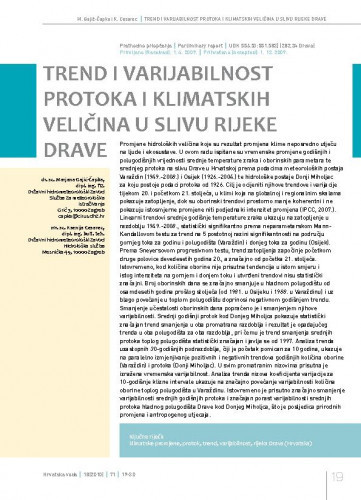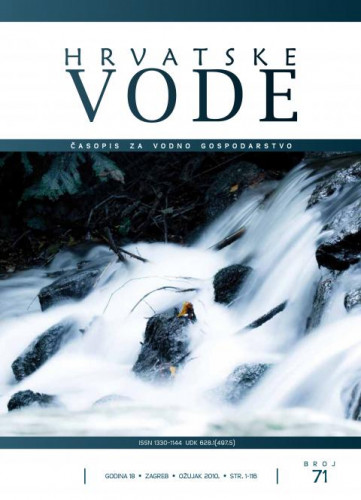Promjene hidroloških veličina koje su rezultat promjena klime neposredno utječu na ljude i ekosustave. U ovom radu ispitane su vremenske promjene godišnjih i polugodišnjih vrijednosti srednje temperature zraka i oborinskih parametara te srednjeg protoka na slivu Drave u Hrvatskoj prema podacima meteoroloških postaja Varaždin (1949.-2008.) i Osijek (1926.-2004.), te hidrološke postaje Donji Miholjac za koju postoje podaci protoka od 1926. Cilj je ocijeniti njihove trendove i varijacije tijekom 20. i početkom 21. stoljeća, u klimi koja na globalnoj i regionalnim skalama pokazuje zatopljenje, dok su oborinski trendovi prostorno manje koherentni i ne pokazuju istosmjerne promjene niti podjednaki intenzitet promjena (IPCC, 2007.). Linearni trendovi srednje godišnje temperature zraka ukazuju na zatopljenje u razdoblju 1949.-2008., statistički signifikantno prema neparametarskom Mann-Kendallovom testu za trend na 5% razini signifikantnosti na području gornjeg toka za godinu i polugodišta (Varaždin) i donjeg toka za godinu (Osijek). Prema Sneyersovom progresivnom testu za trend zatopljenje započinje početkom druge polovice 1990-ih, a značajno od početka 21. stoljeća. Istovremeno kod količina oborine nije prisutna tendencija u istom smjeru i istog intenziteta na gornjem i donjem toku i utvrđeni trendovi nisu statistički značajni. Broj oborinskih dana se značajno smanjuje u hladnom polugodištu od 1980-ih (od 1981. u Osijeku i 1988. u Varaždinu) i uz blago povećanje u toplom polugodištu doprinosi negativnom godišnjem trendu. Smanjenje učestalosti oborinskih dana popraćeno je i smanjenjem njihove varijabilnosti. Srednji godišnji protok kod Donjeg Miholjca pokazuje statistički značajan trend smanjenja u oba promatrana razdoblja i rezultat je opadajućeg trenda u oba polugodišta za oba razdolja, pri čemu je trend smanjenja srednjih protoka toplog polugodišta statistički značajan i javlja se od 1997. Analiza trenda uzastopnih 30-godišnjih podrazdoblja, čiji je početak pomican za 10 godina, ukazuje na paralelno izmjenjivanje pozitivnih i negativnih trendova godišnjih količina oborine (Varaždin) i protoka (Donji Miholjac). U svim promatranim nizovima prisutna je izražena vremenska varijabilnost. Analiza trenda nizova koeficijenta varijacije za 10-godišnje klizne intervale ukazuje na značajno povećanje varijabilnosti količina oborine toplog polugodišta u Varaždinu. Istovremeno je prisutno značajno smanjenje varijabilnosti srednjih godišnjih protoka i značajan porast varijabilnosti srednjih protoka hladnog polugodišta Drave kod Donjeg Miholjca, što je posljedica prirodnih promjena i antropogenog utjecaja..; Changes in hydrological values as a result of climate change directly influence people and ecosystems. This paper investigates changes in the annual and half-year values of mean air temperature and precipitation parameters and mean discharges in the Drava River basin in Croatia according to the data of the meteorological stations Varaždin (1949-2008) and Osijek (1926-2004) as well as the hydrological station Donji Miholjac, for which there are existing discharge data since 1926. The objective is to evaluate the trends and variations in the 20th and at the beginning of the 21st century in climate, which at the global and regional scales show warming up, while precipitation trends are spatially less coherent and do not show the same or similarly intense changes (IPCC, 2007). The linear trends in the mean annual air temperatures show increase in the period 1949-2008, which is statistically significant according to the non-parametric Mann-Kendall test with a 5% significance level in the area of the Upper Drava annually and semi-annually (Varaždin) and the Lower Drava annually (Osijek). According to the Sneyers progressive trend test, the warming up starts at the beginning of the second half of the 1990’s, and is significant from the beginning of the 21st century. Simultaneously, with regards to precipitation quantities, there is no similar trend or the same intensity present in the Upper and the Lower Drava, with the determined trends not statistically significant. The number of precipitation days significantly decreases in the cold half-year in the 1980’s (since 1981 in Osijek and since 1988 in Varaždin), and, with a mild increase in the warm half-year, contributes to the negative annual trend. A decrease in the frequency of precipitation is accompanied by a decrease in their variability. The mean annual discharge at Donji Miholjac shows a statistically significant decreasing trend in both monitored periods and is the result of a decreasing trend in both periods, whereas the decreasing trend in the mean discharges in the warm half-year is statistically significant and appears since 1997. The trend analyses of the successive 30-years sub-periods, with the beginnings shifted by ten years, indicate parallel exchanges of positive and negative annual precipitation trends (Varaždin) and discharges (Donji Miholjac). In all monitored series, there is a present temporal variability. The trend analysis of the variation coefficient series for 10-year intervals indicates a significantly increased variability of precipitation quantities in the warm half-year in Varaždin. At the same time, there is a present significant decrease in the variability of the mean annual discharges and a significant increase in the variability of the mean discharges in the cold half-year for the Drava at Donji Miholjac, which is a consequence of the natural changes and anthropogenic influences.
Sažetak
Dio sveska

